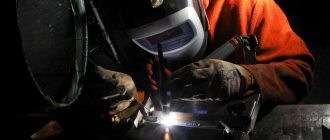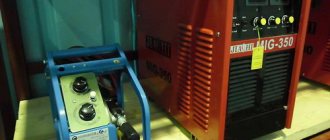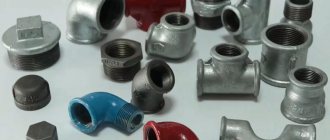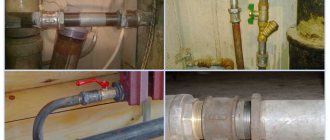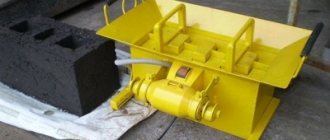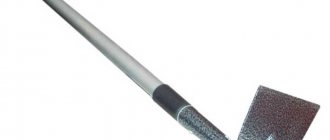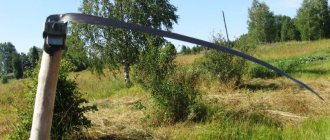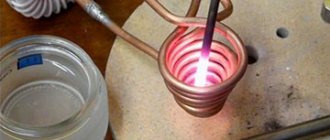Smelting cast iron on an industrial scale is impossible without large, complex and powerful furnaces. A blast furnace is a vertical shaft-type structure in which iron ore is smelted into useful metal. The design of a blast furnace implies continuous operation of the structure for 3-12 years, until major repairs.
Figure 1. Blast furnace
General description of the blast furnace
A blast furnace is a shaft type furnace (Fig. 19). Charge materials - sinter (pellets) and coke - are continuously loaded into the furnace in portions from above, which slowly fall down; the duration of their stay in the furnace is 4...6 hours. Blast - heated air - is supplied to the lower part of the furnace (top of the hearth) through tuyeres; at the tuyeres, due to the oxygen in the blast, coke burns with the release of heat, and the hot combustion products move upward through the charge column, heating it; the residence time of the gases in the furnace is 3...12 s.
Rice. 19. General view of a blast furnace with a double-cone charging apparatus: 1 - foundation; 2 - column; 3— taphole for cast iron production; 4—cast iron gutters; 5 - tuyere devices; b - ring air duct; 7 — casing marator ring; 8 - lining; 9 — steel casing; 10 - fire pit; 11 - large cone; 12 — small cone; 13 — rotating mechanism of the filling device; 14 — receiving funnel; 15, 19 — gas outlets; 16 - skip; 17 - funnel; 18 — inclined bridge; 20 — funnel (bowl); 21—taphole for slag release; 22 - platform.
When the heated charge is lowered, iron is reduced from oxides, which carbonizes, melts and flows down into the furnace in drops, forming cast iron, and unreduced oxides in the lower part of the furnace (bottom of the shaft, steam) melt, forming slag, which also flows into the forge. The cast iron and slag accumulated in the forge, having a temperature of 1450...1500°C, are periodically released through cast iron and slag tapholes.
A general view of a blast furnace equipped with a double-cone charging apparatus is shown in Fig. 19. The furnace rests on foundation 1, most of which is buried in the ground. From the outside, the furnace is enclosed in a solid steel casing 9. Inside the casing there is a lining 8, cooled by refrigerators that are attached to the inner surface of the casing. In the lower part of the furnace (forge) there are tapholes 3 for tapping iron and taphole 21 for tapping slag.
A ring-lined air duct 6 is laid around the furnace, into which hot blast (air) is supplied from the air heaters; the ring air duct serves to supply blast to numerous tuyere devices 5 located around the circumference of the furnace, through which the blast enters the upper part of the hearth.
Above the furnace top 10 there is a top device. It includes gas outlets 15, 19, which serve to remove blast furnace gas from the furnace; a filling (loading) apparatus and a number of other mechanisms associated with the loading of the charge and the removal of gas. The elements of the filling apparatus are shown: a large cone 11 covering the funnel (bowl) 20; a small cone 12 covering the funnel 17, and a mechanism 13 ensuring their rotation; receiving funnel 14, into which the charge materials are poured from the skip 16 by tipping it, and the skip is delivered to the top along the rails of the inclined bridge 18.
The weight of the casing and lining of the upper part of the furnace is transferred to the foundation through the marator ring 7 of the casing and column 2. The liquid cast iron discharged from the furnace through the tap holes 3 enters the cast iron gutters 4 located on the working platform 22 and along them into the cast iron ladles; The slag discharged through tapholes 21 flows through slag chutes located on the site 22 into slag ladle or to a furnace liquid slag granulation unit.
How does a blast furnace work?
This is a huge vertical furnace that operates continuously. Raw materials are fed into the furnace from above, through the loading shaft. The raw materials for smelting are coke, iron ore and additives (limestone), which help extract unnecessary impurities from the ore. The loaded ingredients are heated by hot air in the main part of the blast furnace. During the heating process, coking coal, when burned, releases carbon monoxide, which serves the process of reducing iron ore. The slags that appear during the reduction of iron ore are combined with additives (limestone). At this stage, the slag is in a liquid state, and the released metal is in a solid state.
The metal is lowered through the furnace and undergoes a steaming process. In this section of the furnace, the temperature reaches 1200 degrees Celsius, which contributes to the melting of the metal. Slag, which has a density lower than that of the metal, remains on the molten surface of the metal, which prevents oxidation processes. The speed at which the process of lowering cast iron through the blast furnace occurs is called productivity. The faster it happens, the greater the productivity coefficient of the blast furnace. The separation of slag and finished cast iron is carried out at the last stage through special holes and has its own technological features.
Furnace profile
The profile of a blast furnace is the outline of the working space limited by the lining. In horizontal (transverse) sections, the profile represents circles of variable diameter.
The furnace profile in a vertical axial section is shown in Fig. 20; The main elements of the profile are the hearth, shoulders, steam, shaft and flue, which make up the useful volume of the furnace, i.e. volume from the axis of the cast iron tap hole – O.Ch.L. – to the bottom of the moving elements of the charging apparatus in the lowered position (the useful volume does not include volume 1 of the lower part of the hearth from the axis of the cast iron tap hole to the masonry of the flange, where there is a non-drainable layer of liquid cast iron, and volume 2 limited by the dome 3 of the furnace, in which the elements of the charging apparatus are located ).
Rice. 20. Blast furnace profile
The furnace has the shape of a cylinder and is used to receive the charge loaded from above. Below the top there is a shaft that expands downwards; this expansion is necessary to ensure free descent of the charge materials, the volume of which increases as a result of heating. The rasp, which is a short cylinder, serves to create a smooth transition from the expanding shaft to the tapering shoulders.
The shoulders are made in the form of a truncated cone; this form is necessary because the ore part of the charge melts here, as a result of which the volume of the charge decreases and the tapering shoulders do not allow the charge to descend too quickly into the furnace. The latter has a cylindrical shape, liquid cast iron and slag accumulate in its lower part, and blast is supplied to the upper part and fuel (coke) burns here.
The main size of a blast furnace is the usable volume. In Russia, blast furnaces are built according to standard designs, according to which the following useful volumes, m3, are provided: 1033, 1386, 1513, 1719, 2002, 2300, 2700, 3000, 3200, 4500, 5000 and 5500.
Additional furnace elements
The operation of the oven requires the operation of auxiliary devices. Among them:
- air heaters; large tower-type elements are located next to the furnace; blast furnace gas enters them, which then burns; due to this, even hotter gas is formed, heating the air through a complex system; the latter - heated to a temperature of at least 1000 degrees - is used for smelting cast iron;
- blowers; compressed air is necessary for fuel combustion; air enters the furnace thanks to devices that generate a pressure of about 25 MPa;
- devices for lifting and filling the charge;
- gas purifiers for cleaning blast furnace gases;
- other auxiliary devices - for example, overhead cranes with which foundry yards are equipped.
Figure 4. An example of a modern blast furnace
Modern furnaces are equipped with automation systems. Computerization makes it possible to control and regulate the basic parameters associated with the functioning of the blast furnace. The level of raw material filling, gas pressure, blast temperature, etc. are under control.
Modern blast furnaces are left to automation. The computer controls the main production processes
Foundation, casing and refrigerators
The foundation is the base of the furnace and serves to transfer the load created by the mass of the furnace to the ground. The area of the foundation is calculated taking into account the mass of the furnace (for example, the mass of a furnace with a volume of 5000 m3 with a charge reaches 450 tons) and the fact that the pressure on the ground should not exceed 2.5 kg/cm2.
The foundation consists of two parts (Fig. 21): the lower, underground, called the sole 1, and the upper, called the stump 2. The sole is made of concrete, and the stump is made of refractory concrete with a fire resistance of 1400...1500 °C. Heat resistance is imparted to concrete by using a fireproof filler - fireclay. Portland cement with finely ground additives of fireclay or refractory clay is used as a binder.
Rice. 21. Foundation and bottom of a furnace with a volume of 5500 m3: 1 - base of the foundation; 2 - stump; 3 - carbon blocks; 4 - refrigerators; 5 — air cooling of the bottom of the flange
The sole is made in the form of an octagonal slab 4...6 m thick, the thickness of the stump is 2...3.5 m. The foundation on modern furnaces is protected from overheating and thermal destruction by air cooling the bottom of the flank (the junction of the flank with the stump).
The base of the foundation of most furnaces is supported by steel columns (Fig. 19, 2), which transmit the load of the upper structure of the furnace.
The blast furnace casing is a welded structure consisting of cylindrical and conical belts made of steel sheet. The thickness of the casing in the upper part is 20...40, in the lower part 40...60 mm. The casing is made from steels with high impact strength, strength, ductility, and heat resistance (16G2AF, 10G2S1, 14G2, etc.).
Most furnaces have a casing with a marator or a marator ring (Fig. 19, 7), i.e. a horizontally located ring made of steel sheet, welded to the casing of the lower part of the shaft and the top of the shoulders. Through the marator and columns (Fig. 19, 2) the load of the upper part of the furnace is transferred to the foundation; In addition, the marator serves as a support for the laying of the shaft and the steam chamber.
Domestic furnaces with a volume of 3000...5000 m3, built in recent years, began to be made with self-supporting, i.e. smooth casing without marator ring. At the same time, the conditions for supporting the shaft masonry on the casing have worsened and on the new, more powerful domestic furnace with a volume of 5500 m3, the casing is made self-supporting, but with a small marator ring that serves to support the shaft masonry.
In the furnace casing, cutouts are made for tuyeres, cast iron and slag tapholes, for horizontal refrigerators (if any), as well as holes for the bolts for fastening vertical refrigerators and for the tubes supplying water to them.
Refrigerators are used to cool the lining and furnace casing using cold process water passed through them, and during evaporative cooling, using boiling chemically purified water. Stove-top refrigerators, located vertically between the casing and the lining, are widely used. The refrigerator is a cast iron stove with a steel tube in it in the form of a coil for circulating water. The refrigerator is attached to the stove casing using bolts.
During evaporative cooling, to avoid the formation of vapor locks, boiling water must move from bottom to top; therefore, two or more vertically placed tubes are poured into the slab with water supplied to each of them from below and drained from above.
Koloshnik
This is the upper part of the blast furnace, through which charge materials are loaded and blast furnace or top gas is removed. The main part of the blast furnace device is the filling apparatus. Most blast furnaces have double-cone charging devices. In the normal position, both cones are closed and reliably isolate the interior of the furnace from the atmosphere. After loading the charge into the receiving funnel, the small cone is lowered and the charge falls onto the large cone. The small cone closes. After the specified amount of charge has been collected on the large cone, the large cone is lowered with the small cone closed and the charge is poured into the furnace. After this, the large cone closes. Thus, the working space of the blast furnace is permanently sealed.
Charge materials are usually fed to the furnace throat from one side. As a result, a slope is formed in the funnel of a small cone. Long-term operation of a blast furnace with a skewed charge level is unacceptable. To eliminate this phenomenon, the receiving funnel and the small cone are made rotating. After loading the charge, the funnel together with the cone is rotated through an angle multiple of 60, due to which, after unloading several feeds, the unevenness is completely eliminated. 0
Modern furnaces can install charging devices that are more complex in design. Instead of a large cone, a rotating chute is installed, the angle of which can be adjusted. This design allows you to change the location of the material supply according to the diameter of the top.
During the blast furnace smelting process, a large amount of gas is formed, which is removed from the top part of the furnace. This type of gas is called top gas. The gas contains flammable components CO and H2 and, therefore, is used as a gaseous fuel in metallurgical production. In addition, passing through the charge column, the gas captures small particles of iron-containing materials, forming the so-called flue dust. Dust is collected in special gas purifiers and used as an additive to the charge during agglomeration or pellet production.
Furnace lining
The refractory lining (masonry) of a blast furnace is designed to reduce heat losses and protect the casing from exposure to high temperatures and from contact with liquid metal and slag.
Refractories used . For the lining of a blast furnace, high-quality fireclay bricks, high-alumina bricks, carbon blocks, and sometimes silicon carbide bricks are used. The basis of fireclay is SiO2 and Al2O3.
For blast furnaces, the standard provides for three types of fireclay products with an Al2O3 content of at least 42, 41 and 39%, respectively; they are characterized by increased density and strength, high fire resistance (> 1750 ° C), low Fe2O3 content (
Bricks with a higher Al2O3 content are used for laying the bottom of the furnace, and with a lower content - for laying the top. In addition, for laying furnaces with a volume of ≤1033 m3, the standard provides for a grade of fireclay with a lower (> 37%) Al2O3 content, lower fire resistance (> 1730°C), strength and density. The brick can be 230 mm (normal) and 345 mm (one and a half) long. The use of bricks of different lengths ensures good interlacing of masonry seams.
High-alumina mullite brick used for laying the flange contains > 63% Al2O3 with fire resistance > 1800 °C. Blast-furnace silicon carbide brick contains > 72% SiC and > 7% nitrogen and differs from refractories based on Al2O3 and SiO2 in significantly greater strength and thermal conductivity.
Carbon blocks are made from coke and burnt anthracite with the addition of a small amount of coal tar pitch as a binder. The length of the blocks reaches 3...4 m, they are rectangular in section 400×400 and 550×550 mm. Blocks in combination with large-sized high-alumina bricks (400×200×100 mm) are used for laying the lowest part of the furnace - the flange.
The seams between refractory bricks are filled with mortar made from mortars corresponding to the class of brick. Mortar is a powder consisting of crushed fireclay and refractory clay. For critical types of masonry, mortars are used with the addition of small amounts of surfactants and adhesives (soda, sulfite-alcohol stillage), which makes it possible to prepare solutions with lower humidity while simultaneously increasing their plasticity.
To fill the seams between carbon blocks, a carbon paste consisting of coke and resin is used. The gap between the blocks is allowed no more than 0.5 mm for vertical and no more than 1.5 mm for horizontal seams.
Leschad . Previously, the flanks of blast furnaces were laid out of high-quality fireclay bricks. However, the increase in the volume of furnaces and the intensification of smelting caused the rapid destruction of such masonry. Therefore, at present, flakes are made either all-carbon or combined from carbon and high-alumina refractories. The use of carbon refractories is due to the fact that, due to their high thermal conductivity, overheating is reduced and, as a result, the destruction of the masonry of the flange is reduced.
Horn . The lining of the hearth up to the level of the tuyeres is made of carbon blocks, and in the areas of the tuyeres and cast iron and slag tapholes from fireclay (> 42% Al2O3) bricks, since carbon here can be oxidized by blast oxygen, carbon dioxide (CO2), as well as water vapor from the refractory masses . When working on anhydrous tapping masses, the cast iron taphole area is made of carbon blocks. To prevent oxidation of carbon blocks during the furnace blowing period, they are protected by masonry in one row of fireclay bricks.
The thickness of the lining at the bottom of the hearth reaches 1600 mm. From the outside, the furnace masonry is cooled with smooth stove-top refrigerators.
Shoulders . The masonry of the shoulders is most often made of thin-walled (thickness 230 or 345 mm) from fireclay (> 42% Al2O3) bricks in one row, with the brick adjacent to the peripheral slab refrigerators with poured brick. Sometimes silicon carbide bricks are used instead of fireclay. The masonry of the shoulders quickly wears out and instead of it, a layer of scavenge (frozen slag and small pieces of charge) is formed on the surface of the refrigerators.
Mine and steam . The masonry of the steam chamber and the cooled part of the shaft (~2/3 of its height from below) is made of fireclay (> 41...42% Al2O3) or silicon carbide brick, and the masonry of the upper uncooled part of the shaft is made of fireclay containing > 39% Al2O3. The bricks are laid in two to three rows in a bandage.
The masonry of the shaft with steam can be thick-, medium- and thin-walled. In previous years, thick-walled masonry was widely used (the thickness of the top of the shaft is 800...900 mm and up to 1300 mm in the area of \u200b\u200bthe rasp) with horizontal refrigerators buried in the masonry and serving as its support. However, due to the fact that the refrigerators are located at a distance from each other, the casing is poorly cooled, and after wear of the lining, local overheating occurs, causing thermal deformation and the possibility of cracks.
In addition, cutouts in the casing for installing horizontal refrigerators reduce its strength and make the casing less airtight. In connection with this, thin- and medium-walled shafts have been made in recent years. The thin-walled shaft (and steam) has a masonry thickness of 230...345 mm in the cooled part and 575...690 mm in the upper uncooled part with cooling by vertical finned refrigerators, and some of the refrigerators have horizontal protrusions that serve as support for the masonry and help hold the scull.
The middle-wall shaft has a masonry thickness of 575...900 mm in the cooled part and 700 mm in the uncooled part; cooling is either combined from vertical finned refrigerators in combination with horizontal ones, or from vertical finned refrigerators having horizontal projections.
In the steam and cooled part of the shaft, as the brick wears out, a layer of skull is formed. In order to reduce the pressure from the masonry expanding during heating on the furnace casing and to prevent its rupture, a gap of 70...200 mm is provided between the lining and vertical refrigerators along the entire height of the furnace (except for steam), filled with chamoto-asbestos or plastic carbon mass.
Koloshnik . The fire pit lining itself consists of one row of fireclay bricks laid out near the casing. Behind it there is a “beam protection”, which absorbs the impacts of pieces of charge falling from above during the loading process. Its widespread variety consists of steel segments - cast hollow boxes filled with fireclay bricks. The segments are arranged in several annular rows along the height of the top; adjacent segments around the circumference are connected to each other by bolts.
The entire flue protection is attached to the casing using several hangers, in each of which the segments are attached to a vertical plate connected to an earring, which is freely suspended on a pin inserted into the hole of the bracket; the latter is bolted to the casing. This suspension allows all segments to move upward if the shaft masonry grows in the vertical direction as a result of its heating.
Blast furnace forge
The hearth is conventionally divided into two parts - the upper tuyere zone, where the coke is burned, and the lower one - the metal receiver, which serves to accumulate liquid cast iron and slag, and where the cast iron and slag tapholes are located. The height of the hearth (the distance from the axis of the cast iron taphole to the shoulders) on modern furnaces is 3.2...3.9 m, and on the most powerful domestic furnace with a volume of 5500 m3 it is increased to 5.7 m.
Cast iron tapholes are located 600...1800 mm above the flange, and the part of the metal receiver located below the taphole is filled with a non-draining or “dead” layer of liquid cast iron; this layer is necessary to prevent erosion of the flank by flows of cast iron in the forge and protect it from exposure to high temperatures. Small-volume furnaces have one cast-iron taphole, furnaces with a volume of about 2000 m3 have two, furnaces with a volume of 2700 m3 have three, and furnaces with a volume of 3200...5500 m3 have four tapholes.
On large furnaces with four alternate tap holes, the number of cast iron outputs per day reaches 18...24, on a furnace with a volume of 1000 m3 it is 4...5.
Slag tapholes are located 1.4...2.0 m above the axis of the cast iron tapholes. In furnaces with a volume of 2700 m3 or less, there are two slag tapholes, which are used to release the so-called “upper” slag; in addition, part of the slag flows out along with the produced cast iron through the cast iron tapholes (“bottom” slag). On furnaces with a volume of 3200...5500 m3, which have four cast iron tapholes, almost all the slag comes out through the cast iron tapholes along with the cast iron, and in these furnaces one slag taphole is made, which has a reserve value.
The cast iron tap hole is shown in Fig. 22. The cutout for the tap hole in the furnace casing is framed by a steel ring frame 2 welded to it, lined inside with fireclay bricks. The taphole is a through channel in the masonry of the hearth and frame; this channel, 250...300 mm wide and 400...500 mm high, is filled with fire-resistant tapping mass. To release cast iron into the mass, a hole with a diameter of 50...80 mm is drilled using a drilling machine that rotates the drill. After the cast iron is released, the tap hole channel is clogged with a refractory mass using an electric gun.
Rice. 22. Cast iron tap hole: 1 - furnace casing; 2 — taphole frame; 3 - fireclay masonry; 4 — taphole refrigerator; 5 — tap hole mass; 6 — taphole channel; 7 - liquid cast iron
The slag tapholes are framed with fittings called a slag device, which is placed in the opening of the furnace coolers and attached to the furnace casing. The slag device is shown in Fig. 23.
Rice. 23. Slag device
It consists of telescopically connected elements: a copper welded or stamped hollow water-cooled lance 1 with a diameter of 50...70 mm, a cast copper hollow cooler (slag embrasure) 2, a cast-iron cooler 3 with a filled-in spiral coil for cooling water, a cast-iron water-cooled embrasure 4 of a similar design and frame 5, with which the device is attached to the furnace casing.
All elements of the device have a conical shape, which makes them easier to replace if damaged. The hole in the slag tuyere is closed with a metal plug using a special mechanical stopper. The conical cavity of the slag device is filled with a refractory mass, in which a hole is cut for the slag to exit the furnace. Tubes 6 serve to supply…discharge water to the tuyere.
Tuyere device . In the upper part of the hearth, at a distance of 2700...3500 mm from the axis of the cast iron tap hole of the hearth, air tuyeres are installed along its circumference at equal intervals, through which blast heated to 1100...1300 °C, natural gas and other fuel additives (fuel oil, pulverized coal) enter the furnace ).
On existing furnaces with a volume from 1033 to 5500 m3, the number of tuyeres is 16...42).
The set of devices used to supply blast to the hearth from a ring air duct is called a tuyere device (Fig. 24).
Rice. 24. Tuyere device
The main part of the device is a copper hollow air lance 1 with an internal diameter of 140...190 mm, cooled by water. The tuyere protrudes from the masonry into the furnace at a distance of 300...500 mm.
The tuyere is installed in a copper hollow cast embrasure 2, and the embrasure is installed in a cast iron cooler (tub) 3, which has a cast-iron cooler filled with a spiral tube, which is attached with its flange to the furnace casing using bolts. The lance, embrasure and refrigerator are cooled by running water.
The blast supplied to the tuyere 1 from the annular air duct 12 passes through the sleeve 11 and the fixed pipe (elbow) 10 attached to it; a movable elbow 7, which is attached to the pipe 10 using two hangers 8, and a replaceable nozzle 4. The movable elbow 7 presses the nozzle to the tuyere using a spring tensioning device 5 attached to the furnace casing.
To ensure the tightness of the device (in case of distortions of individual elements as a result of heating, etc.) at the junctions of the lance-nozzle, nozzle-moving elbow and movable elbow-nozzle 10, ball joints are provided (the joints are sharpened along the spherical surface). At the end of the movable elbow there is a glass-covered peephole 6 for monitoring the operation of the tuyere zone.
The sleeve, pipe 10 and the movable elbow are lined inside with fireclay bricks. The nozzle is made of steel with a thin lining on the inside.
The lance and embrasure periodically burn out and to change them, the tension device 5 is disconnected, the suspensions 8 are loosened and the movable elbow is rotated around the axis 9 of the suspensions 8 to a position convenient for removing the nozzle, lance and embrasure.
Ring air duct 12, through which hot blast is supplied to the tuyeres, is lined with fireclay bricks and has a clear diameter of 800...1800 mm, depending on the volume of the furnace.
Blast furnace products
The products of blast furnace smelting are:
- cast iron;
- slag;
- blast furnace (top) gas.
Cast iron
Pig iron is the main product of blast furnace production, and slag and blast furnace gas are by-products.
Cast irons smelted in blast furnaces, depending on the method of further use, are divided into three groups:
- conversion materials used for processing into steel;
- foundries intended for producing cast iron castings in mechanical engineering;
- special (ferroalloys) used for deoxidation of steel in steelmaking.
Cast iron is a multicomponent alloy of iron with carbon, manganese, silicon, phosphorus and sulfur.
Cast iron also contains trace amounts of hydrogen, nitrogen and oxygen. Alloyed cast iron can contain chromium, nickel, vanadium, tungsten and titanium, the amount of which depends on the composition of the ores being smelted.
Pig iron is intended for processing into steel.
This type of cast iron is characterized by the fact that the carbon in it (2.2-4%) is in a chemically bound state.
The fracture surface of cast iron is white.
Depending on the composition and method of processing, there are:
- open hearth cast iron containing phosphorus from 0.15 to 0.30% and sulfur up to 0.07%;
- Bessemer, containing phosphorus 0.07% and sulfur up to 0.069%;
- Tomasovsky, containing phosphorus 1.6% and sulfur up to 0.08%.
Pig iron is divided into three types:
- Conversion coke (grades M1, M2, M3, B1, B2).
- Conversion coke phosphorous (MF1, MF2, MF3).
- High-quality pigment coke (PVK1, PVK2, PVK3).
After leaving the blast furnace, cast iron is poured into pigs and sent cold to machine-building plants, where it is melted again in special cupola furnaces to cast machine parts.
Foundry coke iron is smelted in seven grades: LK1-LK7.
Each grade is divided into three groups based on manganese content, five classes based on phosphorus content and five categories based on sulfur content.
Phosphorous cast irons.
A special group consists of phosphorous cast irons containing up to 2% P; depending on the phosphorus content, various technologies are used for converting such cast irons into steel.
Foundry cast irons.
This type of cast iron is intended for the production of cast products in iron smelting shops. A characteristic feature of these cast irons is their high silicon content (2.75 - 3.75% Si), and in some cases phosphorus. This is explained by the fact that these elements give the molten cast iron high fluid mobility or the ability to fill the casting mold well.
Foundry cast iron is used after remelting in machine-building plants to produce shaped castings.
Foundry cast iron is used for the manufacture of cast products:
- pipes;
- radiators;
- water fittings;
- stanine;
- blocks;
- gears, etc.
Such cast iron has a gray color when fractured. In it, part of the carbon is in a free state, in the form of graphite. Gray cast iron usually contains 1.25-4.25% silicon, 2.5-4% carbon, 0.5-1.3% manganese, 0.1-1.2% phosphorus and a small amount of sulfur.
Manganese gives cast iron its hardness and brittleness.
Silicon, on the contrary, reduces the hardness of cast iron, making castings made from such cast iron easy to machine.
Phosphorus makes cast iron meltable and fills thin sections of molds well.
Castings made of cast iron containing a high amount of phosphorus resist abrasion well, but at the same time have increased fragility.
Sulfur gives cast iron a dense melting point and reduces its mechanical properties.
Special cast irons (ferroalloys).
These are iron alloys with a high content of silicon, manganese and other elements, used as deoxidizers or additives in steelmaking and iron foundries.
These include:
- ferromanganese (70 – 75% Mn and up to 2% Si);
- ferrosilicon (9 – 13% Si and up to 3% Mn);
- mirror cast iron (10 – 15% Mn and up to 2% Si).
In recent years, the smelting of ferroalloys in blast furnaces has decreased due to the uneconomical nature of processing. It is more profitable to smelt ferroalloys in electric furnaces.
Slag
Slag is a by-product; it is a very cheap, high-quality building material and is used to make cement, concrete, bricks, and to prime roads.
The amount of slag obtained during smelting is very large (approximately 60% of the weight of the cast iron being smelted).
Slags are either basic or acidic.
Acidic slag has high strength. If it is blown through in liquid form with steam or air, you get slag wool, which is a good insulator.
